As cities around the world continue to grow, urban developers are searching for sustainable and efficient building solutions. One of the most promising innovations in urban development is the rise of Timber Cities, urban areas built primarily using wood. While concrete and steel have long been the dominant materials in construction, timber is now emerging as an eco-friendly alternative. But what makes timber so special, and how can it shape the future of our cities?
The Benefits of Timber in Urban Development
Timber offers several advantages that make it an attractive option for city development:
- Sustainability – Timber is a renewable resource. Unlike concrete and steel, which require large amounts of energy to produce, wood can be harvested and replanted, making it a more sustainable building material.
- Carbon Sequestration – Trees absorb carbon dioxide from the atmosphere as they grow. When used in construction, this carbon remains stored in the wood, reducing overall greenhouse gas emissions.
- Energy Efficiency – Timber buildings have excellent insulation properties, helping to regulate indoor temperatures naturally and reducing the need for heating and cooling systems.
- Speed of Construction – Prefabricated timber components can be manufactured off-site and assembled quickly, reducing construction time and labor costs.
- Aesthetic and Well-being Benefits – Wooden interiors create a warm and natural ambiance, which can improve mental well-being and create a more pleasant living environment.
Mass Timber: The Game Changer
Traditional wood construction is not new, but recent advancements have led to the rise of mass timber, a category of engineered wood products that includes Cross-Laminated Timber (CLT) and Glue-Laminated Timber (Glulam).
- CLT consists of layers of wood boards stacked in alternating directions and glued together. This gives it strength comparable to concrete and steel while remaining lightweight.
- Glulam is made by bonding layers of lumber together, allowing for the creation of large, strong beams that can support heavy loads.
These materials make it possible to construct high-rise buildings entirely out of wood, challenging the notion that timber is only suitable for low-rise structures.
Timber Cities Around the World
Several cities are already embracing timber construction:
- Oslo, Norway – The Mjøstårnet Tower, standing at 85.4 meters (280 feet), is one of the tallest timber buildings in the world.
- Vancouver, Canada – The Brock Commons Tallwood House, a student residence at the University of British Columbia, showcases the potential of mass timber construction.
- Tokyo, Japan – The W350 Project is an ambitious plan to build a 350-meter (1,148 feet) skyscraper made mostly of wood by 2041.
- London, UK – The Dalston Works is one of the largest CLT buildings in the world, demonstrating how timber can be used in urban housing.
These examples highlight the increasing interest in timber as a sustainable and practical solution for modern urban development.
Addressing Concerns About Timber Cities
While the idea of timber cities is exciting, there are some common concerns:
- Fire Safety: Many people worry about fire risks in wooden buildings. However, mass timber products are designed to be fire-resistant. CLT and Glulam char on the outside when exposed to fire, creating a protective layer that slows down burning and maintains structural integrity.
- Durability and Maintenance: Modern timber treatments and protective coatings make wood highly durable and resistant to pests, moisture, and decay.
- Deforestation and Sustainability: Sustainable forestry practices ensure that trees are replanted and forests are managed responsibly to prevent environmental harm.
- Cost and Scalability: While mass timber buildings can be more expensive upfront, reduced construction time and long-term energy savings make them cost-effective in the long run.
The Future of Timber Cities
The shift towards timber construction is gaining momentum, but what does the future hold?
- Smart Timber Cities
Future cities will likely combine timber with smart technologies, such as energy-efficient designs, solar panels, and IoT (Internet of Things) systems to create sustainable and self-sufficient urban environments.
- Hybrid Construction
While timber can replace many traditional materials, hybrid construction methods combining timber with concrete and steel may become more common to optimize strength and cost-effectiveness.
- Government Policies and Incentives
Many governments are introducing incentives and regulations to encourage sustainable construction, which could accelerate the adoption of timber in urban development.
- Advanced Timber Engineering
Innovations such as 3D-printed wood and bioengineered timber products could further enhance the efficiency and sustainability of wooden buildings.
- Public Awareness and Acceptance
As more timber structures are built and their benefits become widely known, public trust in wooden skyscrapers and urban developments will grow.
Conclusion
Timber cities are no longer a far-fetched dream but a tangible solution for sustainable urban development. With advancements in mass timber technology, strong environmental benefits, and increasing global interest, we may soon see a shift from concrete jungles to wooden metropolises. While challenges remain, ongoing research, innovation, and government support will likely pave the way for a future where timber cities become the new norm.






